Disclosure: this post is not in any way sponsored, endorsed, or otherwise connected with Monthly Java. I paid for my own subscription. I chose to write about the Arizona Monthly Java because I love coffee, not because Monthly Java paid me. (Though if they wanted to pay me to write for them, I wouldn’t be opposed!) If you check out Monthly Java, would you let them know you found them through my review? They might not notice, but it can’t hurt to let them know, right?

Have you heard the good news about coffee?
While procrastinating–wait, I mean researching!–on social media, I happened to run into Monthly Java. It’s a subscription coffee box and like other subscription coffee boxes, it sends you coffee each month. Unlike other boxes, a Monthly Java box contains coffee from local roasters (not big, well-known ones), and each box has two bags from different roasters in the same state. The roasters package the coffee, so it comes to your house in the same packaging as if you’d bought it directly from them (not in some Monthly Java branded package). That means you might get a pound (16 oz) or you might get 12 oz (which seems to be the most common package size on shelves right now), depending on how the roaster packages their beans.
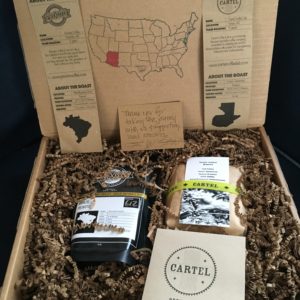
My first box had two coffees from Arizona roasters. Also included were two bookmark-sized brief dossiers on the roasters, some supplemental material from one roaster, and a handwritten thank you note. I liked the low-key, no-fuss packaging. (Hey, I subscribed for the coffee. I don’t need or want ridiculous packaging–I want my money going into the coffee.)
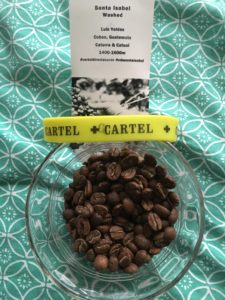
Cartel Coffee Lab
The Roaster. Funny thing, I was already familiar with Cartel, a roaster based in Tempe, AZ, because they have a cafe in the Phoenix Sky Harbor Airport. (Thank god they do. The first time I flew through Phoenix there was literally NO coffee in the nearby terminals. While there’s a Starbucks in the airport now, I prefer the Austin/Portland model of putting local businesses in the airport.) Cartel included the “Cartel Coffee Lab Brew Guide” which lays out the optimal amounts of coffee and water, as well as the process, for making coffee in the Aeropress, Hario V60, Clever, or Chemex. (I have a no-frills $10 4 cup and an Aeropress, but didn’t get around to trying it in the Aeropress.) The website contains all sorts of information about Cartel and coffee in general. Cartel also included a decal, because they think I’m cool enough to have something to put decals on.
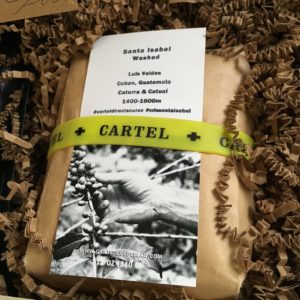
The Facts. The bookmark dossier indicated this Cartel coffee came from Coban, Guatemala from a farm at an elevation of 1400-1600 meters. (It’s not in the online store right now, but other beans are.) The beans were processed using the “washed” process. Since I had no clue what that meant, I visited the Cartel site for an explanation: “Washed coffees are popular where there is an abundance of fresh water. The cherries have an outer layer mechanically stripped off and the inner pulp is allowed to ferment for a prescribed time. The fermented pulp layer is then removed with fresh flowing water.” During my time in Guatemala, I’m pretty sure I saw the residents of El Durazno using this method on their small family plots; they had received clean water only a few months before I was there, and had previously used water carried by hand from a river.
Appearance. Cartel’s beans came in a lined brown bag with a card of coffee info held to the front of the package with a rubber bracelet type thingy (which, it turns out, was just a bit too big to be a bracelet–but it worked great for holding the info card to the mason jar I stored the coffee in.)
When I opened the package and took out the beans, the first thing I noticed is that the beans were a lighter shade of brown than most beans I buy. In addition, the beans had a dry, not oily, appearance and feel. When I put them in my coffee grinder, a few pulses revealed an even lighter interior bean color.
Taste. The bookmark’s tasting notes said “dark chocolate & cranberry.” I’m not sure I got the cranberry, but the aroma was definitely chocolate. I used my usual five scoops per pot (four cup pot, so 1 scoop per cup + “one for the pot”) method. Unadultered, the coffee had a medium level of intensity, and low-to-no feel of acidity. If you are a coffee purist you could drink this straight and be happy. If you are a coffee snob (like me) but like to mess with your coffee (say, by adding milk and a smidge of high-quality hot cocoa mix), that works out very well too.
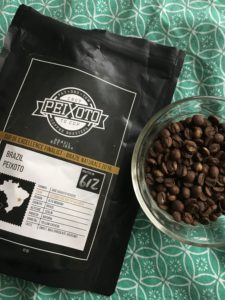
Peixoto Coffee
The Roaster. I had never heard of Peixoto Coffee before, and the bookmark only told me that they source beans from a family farm and are the fourth generation in their coffee-growing family. (How cool is that?) So I went to the website, which has gorgeous pictures of the coffee fruit, and the story of the Peixoto family legacy. (Side note, ye gods do I love the internet. I can get a DIY PhD in coffee right in my living room.) One of the benefits of buying from a family operation like Peixoto Coffee is that the supply chain is short–they grow, roast it, and sell it. That means all of your dollar is paying for the coffee (and the work it took to produce it), instead of intermediate distributors, warehousing, etc. Any coffee Peixoto roasts that doesn’t come from their own farm–such as their Ethiopian beans–is Direct Trade (which is sort of like Fair Trade but with higher standards). Like Cartel, Peix0to also has retail locations, and you can buy online.
The Facts. This particular Peixoto coffee is the yellow catucai, from the Peixoto family’s coffee farm, Fazenda Sao José da Boa Vista, in Alta Mogiana, Brazil. The website has some pictures to give you an idea of what the farm l0oks like, and one of the sliding header photos on the main page shows yellow catucai–the coffee fruit is actually yellow! The beans were processed using the “natural” process. Since I had no idea what that meant, I relied on the Cartel site’s description: “Natural coffees do not use any water and are therefore associated primarily with producing regions that tend to be dryer. With naturals, the fruit is left to shrivel like a raisin before being removed through milling.” Hm, maybe this is the process I observed in Guatemala?
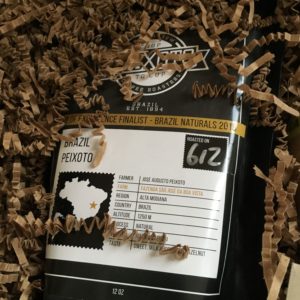
Appearance. Most notable to me, the beans are irregular sizes. You know when you open a typical bag of coffee, all the beans are basically identical? These beans are a mix of the size you expect to see plus all sorts of smaller sizes. I didn’t even need to put them through the grinder to see they had a lighter interior than many beans I use. They had a medium brown external appearance, mostly dry but with a little bit of oiliness. (The oiliness is evident in the empty bag.)
Taste. The bookmark’s tasting notes say “chocolate, mandarin, hazelnut” (the package says “sweet, milk chocolate, hazelnut”). I can definitely understand the milk chocolate–both from the color and the scent of the beans–and the nuttiness. I’m not sure I get “mandarin,” as I didn’t detect the tart citrus taste I expect to go with that word. To the extent “mandarin” is supposed to mean a very slightly sweet, “bright” note, that I do get. Unadultered, this coffee was medium in terms of color (using the exact same process I have described above). It wasn’t 100% acidity-free, as it did have a little citrus-like aspect to it, but the brew also wasn’t so acidic that you could feel it in your teeth. (Monthly Java does advertise that it chooses light to medium roasts, so if you fear the dark, you can still enjoy Monthly Java.) If you’re a purist, this is a fine choice all by itself. It also made a great base for my preferred coffee drink.
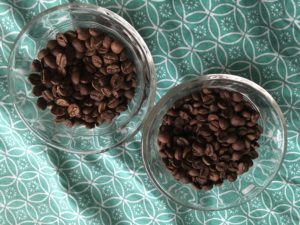
What do you think?
Have you tried Monthly Java or another coffee subscription service? (If not, would you?)
I’ll be the first to admit that a Monthly Java subscription isn’t cheap. Pricing for a single month is $48, paying three months at once brings the cost to $46.56 per month, and the six month plan works out to $45.60 per month. Yet even on the most expensive plan, I would save money–$48 would maybe cover a venti Starbucks mocha for ten days, yet Monthly Java brings me two bags of beans for that cost. Even adding in the most decadent cocoa mix I might use (approx. $10, lasts a month) and the cost of milk, making my drink at home still puts me ahead.

1 Comment
Pingback: Caffeinate Locally! - Train With Bain